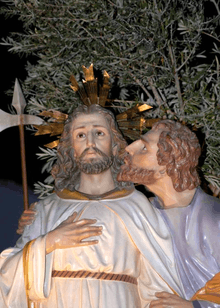Judas Iscariot
Judas Iscariot (/ˈdʒuːdəs ɪˈskærɪət/; Biblical Hebrew: יהודה איש-קריות, romanized: Yehûdâh Ish-Kerayot; Greek: Ὶούδας Ὶσκαριώτης; died c. 30 – c. 33 AD) was a disciple and one of the original Twelve Apostles of Jesus Christ. According to all four canonical gospels, Judas betrayed Jesus to the Sanhedrin in the Garden of Gethsemane by kissing him and addressing him as "rabbi" to reveal his identity to the crowd who had come to arrest him.[1] His name is often used synonymously with betrayal or treason. Judas's epithet Iscariot most likely means he came from the village of Kerioth, but this explanation is not universally accepted and many other possibilities have been suggested.
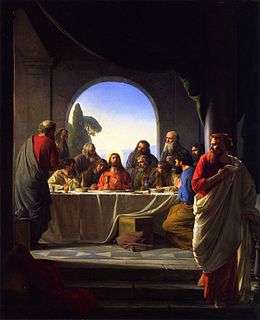
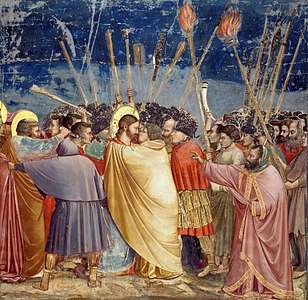
The Gospel of Mark, the earliest gospel, gives no motive for Judas's betrayal, but does present Jesus predicting it at the Last Supper, an event also described in all the later gospels. The Gospel of Matthew 26:15 states that Judas committed the betrayal in exchange for thirty pieces of silver. The Gospel of Luke 22:3 and the Gospel of John 13:27 suggest that he was possessed by Satan. According to Matthew 27:1–10, after learning that Jesus was to be crucified, Judas attempted to return the money he had been paid for his betrayal to the chief priests and committed suicide by hanging. The priests used the money to buy a field to bury strangers in, which was called the "Field of Blood" because it had been bought with blood money. The Book of Acts 1:18 quotes Peter as saying that Judas used the money to buy the field himself and, he "[fell] headlong... burst asunder in the midst, and all his bowels gushed out." His place among the Twelve Apostles was later filled by Matthias.
Due to his notorious role in all the gospel narratives, Judas remains a controversial figure in Christian history. For instance, Judas's betrayal is seen as setting in motion the events that led to Jesus's crucifixion and resurrection, which, according to traditional Christian theology, brought salvation to humanity. The Gnostic Gospel of Judas – rejected by the proto-orthodox Church as heretical – portrays Judas's actions as done in obedience to instructions given to him by Jesus, and that he alone amongst the disciples knew Jesus's true teachings. Since the Middle Ages, Judas has sometimes been portrayed as a personification of the Jewish people and his betrayal has been used to justify Christian antisemitism.[2]
Historicity
Although Judas Iscariot's historical existence is generally widely accepted among secular historians,[3][4][5][6] this relative consensus has not gone entirely unchallenged.[4] The earliest possible allusion to Judas comes from the First Epistle to the Corinthians 11:23–24, in which Paul the Apostle does not mention Judas by name,[7][8] but uses the passive voice of the Greek word paradídōmi (παραδίδωμι), which most Bible translations render as "was betrayed":[7][8] "...the Lord Jesus on the night when he was betrayed took a loaf of bread..."[7] Nonetheless, many biblical scholars argue that the word paradídōmi should be translated as "was handed over".[7][8] This translation could still refer to Judas,[7][8] but it could also instead refer to God metaphorically "handing Jesus over" to the Romans.[7]
In his book Antisemitism and Modernity (2006), the Jewish scholar Hyam Maccoby suggests that, in the New Testament, the name "Judas" was constructed as an attack on the Judaeans or on the Judaean religious establishment held responsible for executing Jesus.[9][10] In his book The Sins of Scripture (2009), John Shelby Spong concurs with this argument,[11][12] insisting, "The whole story of Judas has the feeling of being contrived ... The act of betrayal by a member of the twelve disciples is not found in the earliest Christian writings. Judas is first placed into the Christian story by the Gospel of Mark (3:19), who wrote in the early years of the eighth decade of the Common Era."[11]
Most scholars reject these arguments for non-historicity,[5][13][14][15] noting that there is nothing in the gospels to associate Judas with Judeans except his name, which was an extremely common one for Jewish men during the first century,[13][16][8] and that numerous other figures named "Judas" are mentioned throughout the New Testament, none of whom are portrayed negatively.[13][16][8] Positive figures named Judas mentioned in the New Testament include the prophet Judas Barsabbas (Acts 15:22–33), Jesus's brother Jude (Mark 6:3; Matt 13:55; Jude 1), and the apostle Judas the son of James (Luke 6:14–16; Acts 1:13; John 14:22).[13] B. J. Oropeza argues that Christians should not repeat the historic tragedy of associating Judas Iscariot with the Judeans but regard him instead as an emergent Christian apostate, and hence, one of their own.[13] His betrayal over a sum of money warns auditors against the vice of greed.[13]
Life
Name and background
_-_James_Tissot.jpg)
The name Judas (Ὶούδας) is a Greek rendering of the Hebrew name Judah (יהודה, Yehûdâh, Hebrew for "God is thanked"), which was an extremely common name for Jewish men during the first century AD, due to the renowned hero Judas Maccabeus.[16][8] Consequently, numerous other figures with this name are mentioned throughout the New Testament.[13][16][8] In the Gospel of Mark 3:13–19, the earliest of all the gospels, which was written in the mid 60s or early 70s AD, Judas Iscariot is the only apostle named Judas.[8] Matthew 10:2–4 follows this portrayal.[8] The Gospel of Luke 6:12–19, however, replaces the apostle whom Mark and Matthew call "Thaddeus" with "Judas son of James".[8] Peter Stanford suggests that this renaming may represent an effort by the author of the Gospel of Luke to create a "good Judas" in contrast to the betrayer Judas Iscariot.[8]
Judas's epithet Iscariot (Ὶσκάριωθ or Ὶσκαριώτης), which distinguishes him from the other people named Judas in the gospels, is usually thought to be a Greek rendering of the Hebrew phrase איש־קריות, (Κ-Qrîyôt), meaning "the man from Kerioth".[16][8][17] This interpretation is supported by the statement in the Gospel of John 6:71 that Judas was "the son of Simon Iscariot".[8] Nonetheless, this interpretation of the name is not fully accepted by all scholars.[16][8] One of the most popular alternative explanations holds that Iscariot (ܣܟܪܝܘܛܐ 'Skaryota' in Syriac Aramaic, per the Peshitta text) may be a corruption of the Latin word sicarius, meaning "dagger man",[16][8][18][19] which referred to a member of the Sicarii (סיקריים in Aramaic), a group of Jewish rebels who were known for committing acts of terrorism in the 40s and 50s AD by assassinating people in crowds using long knives hidden under their cloaks.[16][8] This interpretation is problematic, however, because there is nothing in the gospels to associate Judas with the Sicarii,[8] and there is no evidence that the cadre existed during the 30s AD when Judas was alive.[20][8]
A possibility advanced by Ernst Wilhelm Hengstenberg is that Iscariot means "the liar" or "the false one," perhaps from the Aramaic אִשְׁקַרְיָא.[21] Stanford rejects this, noting that the gospel-writers follow Judas's name with the statement that he betrayed Jesus, so it would be redundant for them to call him "the false one" before immediately stating that he was a traitor.[8] Some have proposed that the word derives from an Aramaic word meaning "red color," from the root סקר.[22] Another hypothesis holds that the word derives from one of the Aramaic roots סכר or סגר. This would mean "to deliver," based on the LXX rendering of Isaiah 19:4 – a theory advanced by J. Alfred Morin.[21] The epithet could also be associated with the manner of Judas's death, i.e., hanging. This would mean Iscariot derives from a kind of Greek-Aramaic hybrid: אִסְכַּרְיוּתָא, Iskarioutha, "chokiness" or "constriction." This might indicate that the epithet was applied posthumously by the remaining disciples, but Joan E. Taylor has argued that it was a descriptive name given to Judas by Jesus, since other disciples such as Simon Peter/Cephas (Kephas "rock") were also given such names.[21]
Role as an apostle

Although the canonical gospels frequently disagree on the names of some of the minor apostles,[23] all four of them list Judas Iscariot as one of them.[23][8] The Synoptic Gospels state that Jesus sent out "the twelve" (including Judas) with power over unclean spirits and with a ministry of preaching and healing: Judas clearly played an active part in this apostolic ministry alongside the other eleven.[24] However, in John's Gospel, Judas's outlook was differentiated – many of Jesus' disciples abandoned him because of the difficulty of accepting his teachings, and Jesus asked the twelve if they would also leave him. Simon Peter spoke for the twelve: "Lord, to whom shall we go? You have the words of eternal life," but Jesus observed then that despite the fact that he himself had chosen the twelve, one of them (unnamed by Jesus, but identified by the narrator) was "a devil" who would betray him.[25]
One of the best-attested and most reliable statements made by Jesus in the gospels comes from the Gospel of Matthew 19:28, in which Jesus tells his apostles: "in the new world, when the Son of Man shall sit on his glorious throne, you will also sit on twelve thrones, judging the twelve tribes of Israel."[23] New Testament scholar Bart D. Ehrman concludes, "This is not a tradition that was likely to have been made up by a Christian later, after Jesus's death—since one of these twelve had abandoned his cause and betrayed him. No one thought that Judas Iscariot would be seated on a glorious throne in the Kingdom of God. That saying, therefore appears to go back to Jesus, and indicates, then, that he had twelve close disciples, whom he predicted would reign in the coming Kingdom."[23]
Matthew directly states that Judas betrayed Jesus for a bribe of "thirty pieces of silver"[26][27] by identifying him with a kiss – "the kiss of Judas" – to arresting soldiers of the High Priest Caiaphas, who then turned Jesus over to Pontius Pilate's soldiers.
Mark's Gospel states that the chief priests were looking for a way to arrest Jesus. They decided not to do so during the feast [of the Passover], since they were afraid that people would riot;[28] instead, they chose the night before the feast to arrest him. According to Luke's account, Satan entered Judas at this time.[29]
According to the account in the Gospel of John, Judas carried the disciples' money bag or box (Greek: γλωσσόκομον, glōssokomon),[30] but John's Gospel makes no mention of the thirty pieces of silver as a fee for betrayal. The evangelist comments in John 12:5–6 that Judas spoke fine words about giving money to the poor, but the reality was "not that he cared for the poor, but [that] he was a thief, and had the money box; and he used to take what was put in it." However, in John 13:27–30, when Judas left the gathering of Jesus and his disciples with betrayal in mind,[31] some [of the disciples] thought that Judas might have been leaving to buy supplies or on a charitable errand.
Ehrman argues that Judas's betrayal "is about as historically certain as anything else in the tradition",[3][16] pointing out that the betrayal is independently attested in the Gospel of Mark, in the Gospel of John, and in the Book of Acts.[3][16] Ehrman also contends that it is highly unlikely that early Christians would have made the story of Judas's betrayal up, since it reflects poorly on Jesus's judgement in choosing him as an apostle.[3][32] Nonetheless, Ehrman argues that what Judas actually told the authorities was not Jesus's location, but rather Jesus's secret teaching that he was the Messiah.[3] This, he holds, explains why the authorities did not try to arrest Jesus prior to Judas's betrayal.[3] John P. Meier sums up the historical consensus, stating, "We only know two basic facts about [Judas]: (1) Jesus chose him as one of the Twelve, and (2) he handed over Jesus to the Jerusalem authorities, thus precipitating Jesus' execution."[33]
Death
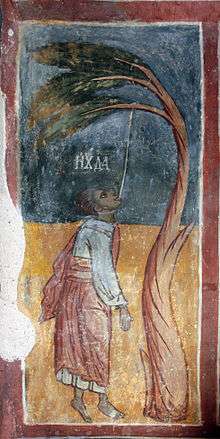
Many different accounts of Judas' death have survived from antiquity, both within and outside the New Testament.[34][35] Matthew 27:1–10 states that, after learning that Jesus was to be crucified, Judas was overcome by remorse and attempted to return the 30 pieces of silver to the priests, but they would not accept them because they were blood money, so he threw them on the ground and left. Afterwards, he committed suicide by hanging himself.[36] The priests used the money to buy a potter's field, which became known as Akeldama (חקל דמא – khakel dama) – the Field of Blood – because it had been bought with blood money.[36] Acts 1:18 states that Judas used the money to buy a field,[36][37] and "[fell] headlong... burst asunder in the midst, and all his bowels gushed out."[36] The field became known as Akeldama, which means "the Field of Blood" in Aramaic, because it was covered in Judas's blood,[36] and it was used to bury strangers.[36] In this account, Judas' death is apparently by accident[36] and he shows no signs of remorse.[36]
The early Church Father Papias of Hierapolis (c. 60–130 AD) recorded in his Expositions of the Sayings of the Lord, which was probably written during the first decade of the second century AD, that Judas was afflicted by God's wrath;[38][39] his body became so enormously bloated that he could not pass through a street with buildings on either side.[38][39] His face became so swelled up that a doctor could not even identify the location of his eyes using an optical instrument.[38] Judas' genitals became enormously swollen and oozed with pus and worms.[38] Finally, he killed himself on his own land by pouring out his innards onto the ground,[38][39] which stank so horribly that, even in Papias' own time a century later, people still could not pass the site without holding their noses.[38][39] This story was well known among Christians in antiquity[39] and was often told in competition with the two conflicting stories from the New Testament.[39]
According to the apocryphal Gospel of Nicodemus, which was probably written in the fourth century AD, Judas was overcome with remorse[40] and went home to tell his wife, who was roasting a chicken on a spit over a charcoal fire, that he was going to kill himself, because he knew Jesus would rise from the dead and, when he did, he would punish him.[40] Judas's wife laughed and told him that Jesus could no more rise from the dead than he could resurrect the chicken she was cooking.[34] Immediately, the chicken was restored to life and began to crow.[38] Judas then ran away and hanged himself.[38] In the apocryphal Gospel of Judas, Judas has a vision of the disciples stoning and persecuting him.[41]
The discrepancy between the two different accounts of Judas's death in Matthew 27:1–10 and Acts 1:18 has proven to be a serious challenge to those who support the idea of Biblical inerrancy.[40][39][42] This problem was one of the points leading C. S. Lewis, for example, to reject the view "that every statement in Scripture must be historical truth".[43] Nonetheless, various attempts at harmonization have been suggested.[39] Generally they have followed literal interpretations such as that of Augustine of Hippo, which suggest that these simply describe different aspects of the same event – that Judas hanged himself in the field, and the rope eventually snapped and the fall burst his body open,[44][45] or that the accounts of Acts and Matthew refer to two different transactions.[46] Some have taken the descriptions as figurative: that the "falling prostrate" was Judas in anguish,[lower-alpha 1] and the "bursting out of the bowels" is pouring out emotion.[lower-alpha 2]
Modern scholars reject these approaches.[47][48][49] Arie W. Zwiep states that "neither story was meant to be read in light of the other"[39] and that "the integrity of both stories as complete narratives in themselves is seriously disrespected when the two separate stories are being conflated into a third, harmonized version."[39] David A. Reed argues that the Matthew account is a midrashic exposition that allows the author to present the event as a fulfillment of prophetic passages from the Old Testament. They argue that the author adds imaginative details such as the thirty pieces of silver, and the fact that Judas hangs himself, to an earlier tradition about Judas's death.[50]
Matthew's description of the death as fulfilment of a prophecy "spoken through Jeremiah the prophet" has caused difficulties, since it does not clearly correspond to any known version of the Book of Jeremiah but does appear to refer to a story from the Book of Zechariah[51] which describes the return of a payment of thirty pieces of silver.[52] Even writers such as Jerome and John Calvin concluded that this was obviously an error.[lower-alpha 3] Modern scholars however have usually explained apparent discrepancies of this sort as arising from a Jewish practice of citing the Major Prophet in a scroll group to refer to the whole content of the scroll group, including books written by minor prophets placed in the grouping.[53]
More recently, scholars have suggested that the Gospel writer may also have had a passage from Jeremiah in mind,[54] such as chapters 18:1–4 and 19:1–13 which refer to a potter's jar and a burial place, and chapter 32:6–15 which refers to a burial place and an earthenware jar.[55] Raymond Brown suggested, "the most plausible [explanation] is that Matthew 27:9–10 is presenting a mixed citation with words taken both from Zechariah and Jeremiah, and ... he refers to that combination by one name. Jeremiah 18–9 concerns a potter (18:2–; 19:1), a purchase (19:1), the Valley of Hinnom (where the Field of Blood is traditionally located, 19:2), 'innocent blood' (19:4), and the renaming of a place for burial (19:6, 11); and Jer 32:6–5 tells of the purchase of a field with silver."[56] Randel Helms gives this as an example of the 'fictional and imaginative' use by early Christians of the Old Testament: "Matthew's source has blended Jeremiah's buying of a field and placing the deed in a pot with Zechariah's casting of 30 pieces of silver down in the temple and the purchase of the Potter's Field."[57]
Theology
Betrayal of Jesus
_Cropped.jpg)
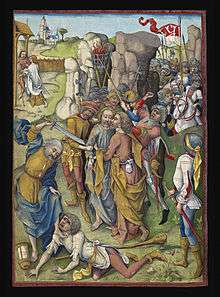
There are several explanations as to why Judas betrayed Jesus.[58] In the earliest account, in the Gospel of Mark, when he goes to the chief priests to betray Jesus, he is offered money as a reward, but it is not clear that money is his motivation.[59] In the Gospel of Matthew account, on the other hand, he asks what they will pay him for handing Jesus over.[60] In the Gospel of Luke[61] and the Gospel of John,[62] the devil enters into Judas, causing him to offer to betray Jesus. The Gospel of John account has Judas complaining that money has been spent on expensive perfumes to anoint Jesus which could have been spent on the poor, but adds that he was the keeper of the apostles' purse and used to steal from it.[63]
One suggestion has been that Judas expected Jesus to overthrow Roman rule of Judea. In this view, Judas is a disillusioned disciple betraying Jesus not so much because he loved money, but because he loved his country and thought Jesus had failed it.[58] Another is that Jesus was causing unrest likely to increase tensions with the Roman authorities and they thought he should be restrained until after the Passover, when everyone had gone back home and the commotion had died down.[64]
The Gospels suggest that Jesus foresaw (John 6:64, Matthew 26:25) and allowed Judas' betrayal (John 13:27–28).[42] One explanation is that Jesus allowed the betrayal because it would allow God's plan to be fulfilled. Another is that regardless of the betrayal, Jesus was ultimately destined for crucifixion.[65] In April 2006, a Coptic papyrus manuscript titled the Gospel of Judas from 200 AD was translated, suggesting that Jesus told Judas to betray him,[66] although some scholars question the translation.[67][68]
Judas is the subject of philosophical writings. Origen of Alexandria, in his Commentary on John's Gospel, reflected on Judas's interactions with the other apostles and Jesus' confidence in him prior to his betrayal.[69] Other philosophical reflections on Judas include The Problem of Natural Evil by Bertrand Russell and "Three Versions of Judas," a short story by Jorge Luis Borges. They allege various problematic ideological contradictions with the discrepancy between Judas' actions and his eternal punishment. Bruce Reichenbach argues that if Jesus foresees Judas' betrayal, then the betrayal is not an act of free will,[70] and therefore should not be punishable. Conversely, it is argued that just because the betrayal was foretold, it does not prevent Judas from exercising his own free will in this matter.[71] Other scholars argue that Judas acted in obedience to God's will.[72] The gospels suggest that Judas is apparently bound up with the fulfillment of God's purposes (John 13:18, John 17:12, Matthew 26:23–25, Luke 22:21–22, Matt 27:9–10, Acts 1:16, Acts 1:20),[42] yet "woe is upon him", and he would "have been better unborn" (Matthew 26:23–25). The difficulty inherent in the saying is its paradox: if Judas had not been born, the Son of Man would apparently no longer do "as it is written of him." The consequence of this apologetic approach is that Judas' actions come to be seen as necessary and unavoidable, yet leading to condemnation.[73] Another explanation is that Judas' birth and betrayal did not necessitate the only way the Son of Man could have suffered and been crucified. The earliest churches believed "as it is written of him" to be prophetic, fulfilling Scriptures such as that of the suffering servant in Isaiah 52–53 and the righteous one in Psalm 22, which do not require betrayal (at least by Judas) as the means to the suffering. Regardless of any necessity, Judas is held responsible for his act (Mark 14:21; Luke 22:22; Matt 26:24).[74]
Erasmus believed that Judas was free to change his intention, but Martin Luther argued in rebuttal that Judas' will was immutable. John Calvin states that Judas was predestined to damnation, but writes on the question of Judas' guilt: "surely in Judas' betrayal, it will be no more right, because God himself willed that his son be delivered up and delivered him up to death, to ascribe the guilt of the crime to God than to transfer the credit for redemption to Judas."[75] The Catholic Church has no view on his damnation. The Vatican only proclaims individuals' Eternal Salvation through the Canon of Saints. There is no 'Canon of the Damned', nor any official proclamation of the damnation of Judas.
It is speculated that Judas's damnation, which seems possible from the Gospels' text, may not stem from his betrayal of Christ, but from the despair which caused him to subsequently commit suicide.[76]
In his book The Passover Plot (1965), British New Testament scholar Hugh J. Schonfield suggested that the crucifixion of Christ was a conscious re-enactment of Biblical prophecy and that Judas acted with the full knowledge and consent of Jesus in "betraying" him to the authorities. The book has been variously described as 'factually groundless',[77] based on 'little data' and 'wild suppositions',[78] 'disturbing' and 'tawdry'.[79]
In his 1970 book Theologie der Drei Tage (English translation: Mysterium Paschale), Hans Urs von Balthasar emphasizes that Jesus was not betrayed but surrendered and delivered up by himself, since the meaning of the Greek word used by the New Testament, paradidonai (παραδιδόναι, Latin: tradere), is unequivocally "handing over of self".[80][81] In the "Preface to the Second Edition", Balthasar takes a cue from Revelation 13:8[82] (Vulgate: agni qui occisus est ab origine mundi, NIV: "the Lamb who was slain from the creation of the world") to extrapolate the idea that God as "immanent Trinity" can endure and conquer godlessness, abandonment, and death in an "eternal super-kenosis".[83][84]
Role in apocrypha
Judas has been a figure of great interest to esoteric groups, such as many Gnostic sects. Irenaeus records the beliefs of one Gnostic sect, the Cainites, who believed that Judas was an instrument of the Sophia, Divine Wisdom, thus earning the hatred of the Demiurge. His betrayal of Jesus thus was a victory over the materialist world. The Cainites later split into two groups, disagreeing over the ultimate significance of Jesus in their cosmology.
The Syriac Infancy Gospel
The Syriac Infancy Gospel[85] borrows from some the different versions of the Infancy Gospel of Thomas.[86] However, it adds many of its own tales, probably from local legends, including one of Judas. This pseudepigraphic work tells how Judas, as a boy, was possessed by Satan, who caused him to bite himself or anyone else present. In one of these attacks, Judas bit the young Jesus in the side; and, by touching Him, Satan was exorcised. It further states that the side which Judas supposedly bit was the same side that was pierced by the Holy Lance at the Crucifixion.[87]
Gospel of Judas
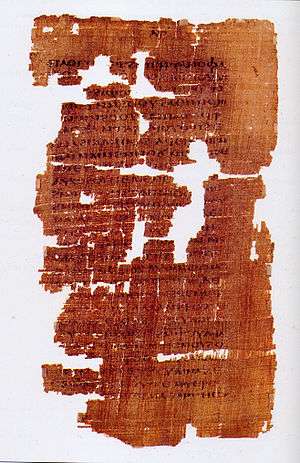
During the 1970s, a Coptic papyrus codex (book) was discovered near Beni Masah, Egypt. It appeared to be a 3rd- or 4th-century-AD copy of a 2nd-century original,[88][89] relating a series of conversations in which Jesus and Judas interact and discuss the nature of the universe from a Gnostic viewpoint. The discovery was given dramatic international exposure in April 2006 when the US National Geographic magazine published a feature article entitled "The Gospel of Judas" with images of the fragile codex and analytical commentary by relevant experts and interested observers (but not a comprehensive translation). The article's introduction stated: "An ancient text lost for 1,700 years says Christ's betrayer was his truest disciple."[90] The article points to some evidence that the original document was extant in the 2nd century: "Around A.D. 180, Irenaeus, Bishop of Lyon in what was then Roman Gaul, wrote a massive treatise called Against Heresies [in which he attacked] a 'fictitious history,' which 'they style the Gospel of Judas.'"[91]
Before the magazine's edition was circulated, other news media gave exposure to the story, abridging and selectively reporting it.[66]
In December 2007, a New York Times op-ed article by April DeConick asserted that the National Geographic's translation is badly flawed: For example, in one instance the National Geographic transcription refers to Judas as a "daimon," which the society's experts have translated as "spirit." However, the universally accepted word for "spirit" is "pneuma"—in Gnostic literature "daimon" is always taken to mean "demon."[92] The National Geographic Society responded that "Virtually all issues April D. DeConick raises about translation choices are addressed in footnotes in both the popular and critical editions."[93] In a later review of the issues and relevant publications, critic Joan Acocella questioned whether ulterior intentions had not begun to supersede historical analysis, e.g., whether publication of The Gospel of Judas could be an attempt to roll back ancient anti-semitic imputations. She concluded that the ongoing clash between scriptural fundamentalism and attempts at revision were childish because of the unreliability of the sources. Therefore, she argued, "People interpret, and cheat. The answer is not to fix the Bible but to fix ourselves."[94] Other scholars have questioned the initial translation and interpretation of the Gospel of Judas by the National Geographic team of experts.[67]
Gospel of Barnabas
According to medieval copies (the earliest copies from the 15th century) of the Gospel of Barnabas it was Judas, not Jesus, who was crucified on the cross. This work states that Judas's appearance was transformed to that of Jesus', when the former, out of betrayal, led the Roman soldiers to arrest Jesus who by then was ascended to the heavens. This transformation of appearance was so identical that the masses, followers of Christ, and even the Mother of Jesus, Mary, initially thought that the one arrested and crucified was Jesus himself. The gospel then mentions that after three days since burial, Judas' body was stolen from his grave, and then the rumors spread of Jesus being risen from the dead. When Jesus was informed in the third heaven about what happened, he prayed to God to be sent back to the earth, and descended and gathered his mother, disciples, and followers, and told them the truth of what happened. He then ascended back to the heavens, and will come back at the end of times as a just king.
This Gospel is considered by the majority of Christians to be late and pseudepigraphical; however, some academics suggest that it may contain some remnants of an earlier apocryphal work (perhaps Gnostic, Ebionite or Diatessaronic), redacted to bring it more in line with Islamic doctrine. Some Muslims consider the surviving versions as transmitting a suppressed apostolic original. Some Islamic organizations cite it in support of the Islamic view of Jesus.
Representations and symbolism
The term Judas has entered many languages as a synonym for betrayer, and Judas has become the archetype of the traitor in Western art and literature. Judas is given some role in virtually all literature telling the Passion story, and appears in numerous modern novels and movies.
In the Eastern Orthodox hymns of Holy Wednesday (the Wednesday before Pascha), Judas is contrasted with the woman who anointed Jesus with expensive perfume and washed his feet with her tears. According to the Gospel of John, Judas protested at this apparent extravagance, suggesting that the money spent on it should have been given to the poor. After this, Judas went to the chief priests and offered to betray Jesus for money. The hymns of Holy Wednesday contrast these two figures, encouraging believers to avoid the example of the fallen disciple and instead to imitate Mary's example of repentance. Also, Wednesday is observed as a day of fasting from meat, dairy products, and olive oil throughout the year in memory of the betrayal of Judas. The prayers of preparation for receiving the Eucharist also make mention of Judas's betrayal: "I will not reveal your mysteries to your enemies, neither like Judas will I betray you with a kiss, but like the thief on the cross I will confess you."
Judas Iscariot is often shown with red hair in Spanish culture[95][96][97] and by William Shakespeare.[97][98] The practice is comparable to the Renaissance portrayal of Jews with red hair, which was then regarded as a negative trait and which may have been used to correlate Judas Iscariot with contemporary Jews.[99]
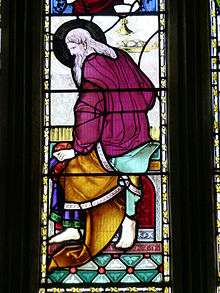
In paintings depicting the Last Supper, Judas is occasionally depicted with a dark-colored halo (contrasting with the lighter halos of the other apostles) to signify his former status as an apostle. More commonly, however, he is the only one at the table without one. In some church stained glass windows he is also depicted with a dark halo such as in one of the windows of the Church of St John the Baptist, Yeovil.
Art and literature
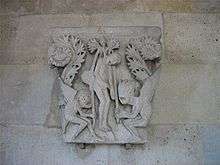
Judas is the subject of one of the oldest surviving English ballads, which dates from the 13th century. In the ballad, the blame for the betrayal of Christ is placed on his sister.[100] In Dante's Inferno, Judas is condemned to the lowest circle of Hell: the Ninth Circle of Traitors, also known as the frozen lake, Cocytus. He is one of three sinners deemed evil enough to be doomed to an eternity of being chewed in the mouths of the triple-headed Satan (the others being Brutus and Cassius, the assassins of Julius Caesar). Dante writes that Judas – having committed the ultimate act of treachery by betraying the Son of God Himself – is trapped in the jaws of Satan's central head, said to be the most vicious of the three, by his head, leaving his back to be raked by the fallen angel's claws.[101] In art, one of the most famous depictions of Judas Iscariot and his kiss of betrayal of Jesus is The Taking of Christ by Italian Baroque artist, Caravaggio, done in 1602.[102]
In Memoirs of Judas (1867) by Ferdinando Petruccelli della Gattina, he is seen as a leader of the Jewish revolt against the rule of Romans.[103] Edward Elgar's oratorio, The Apostles, depicts Judas as wanting to force Jesus to declare his divinity and establish the kingdom on earth.[104] In Trial of Christ in Seven Stages (1909) by John Brayshaw Kaye, the author did not accept the idea that Judas intended to betray Christ, and the poem is a defence of Judas, in which he adds his own vision to the biblical account of the story of the trial before the Sanhedrin and Caiaphas.[105]
In Mikhail Bulgakov's novel The Master and Margarita, Judas is paid by the high priest of Judaea to testify against Jesus, who had been inciting trouble among the people of Jerusalem. After authorizing the crucifixion, Pilate suffers an agony of regret and turns his anger on Judas, ordering him assassinated. The story within a story appears as a counter-revolutionary novel in the context of Moscow in the 1920s–1930s.[106] "Tres versiones de Judas" (English title: "Three Versions of Judas") is a short story by Argentine writer and poet Jorge Luis Borges. It was included in Borges' anthology, Ficciones, published in 1944, and revolves around the main character's doubts about the canonical story of Judas who instead creates three alternative versions.[107] On April 17, 1945, the radio program Inner Sanctum broadcast the story "The Judas Clock", in which the cursed title object, a 16th-century Italian marble longcase clock, is unable to run without the thirty silver coins of Judas being placed in its hollow weights. The episode's main character, played by Berry Kroeger, recites the fate of Judas from Matthew 27:5 (King James version) at the episode's conclusion.
The 1971 novel I, Judas by Taylor Caldwell and Jess Stearn (ISBN 978-0451121134) was one of the first published novels to portray Judas in a more sympathetic light. In the 1977 television miniseries Jesus Of Nazareth, Judas was famously portrayed by Ian McShane, in a critically acclaimed performance. He is portrayed as being torn between personal loyalty to his Rabbi and social loyalty to the Sanhedrin. Ultimately he is "seduced" into betraying Jesus by the temple scribe Zerah, the fictional character who acts as the series lead villain.
In Martin Scorsese's 1988 film The Last Temptation of Christ, based on the novel by Nikos Kazantzakis, Judas' only motivation in betraying Jesus to the Romans was to help him accomplish his mission by mutual agreement, making Judas the catalyst for the event later interpreted as bringing about humanity's salvation.[108] In the film Dracula 2000, Dracula (played by Gerard Butler) is revealed in this version to be Judas. God punishes Judas, not only for betraying Jesus, but attempting suicide at dawn, by turning him into the first vampire, and making him vulnerable to silver for taking 30 pieces of silver as payment for his betrayal, and his suicide attempt at dawn also tries to explain a vampire's violent reaction to sunlight.[109] In The Last Days of Judas Iscariot (2005), a critically acclaimed play by Stephen Adly Guirgis, Judas is given a trial in Purgatory.[110] In C. K. Stead's 2006 novel My Name Was Judas, Judas, who was then known as Idas of Sidon, recounts the story of Jesus as recalled by him some forty years later.[111]
In September 2017, Boom Studios announced a four-issue comics Judas, written by Jeff Loveness and Jakub Rebelka.[112] In March 2018, BBC Radio 4's 15 Minute Drama broadcast Judas, written by Lucy Gannon, in 5 episodes with Damien Molony in the title role.[113] In the March 2018 film Mary Magdalene, written by Helen Edmundson, Judas is played by Tahar Rahim.[114]
Judas is a lead role in Andrew Lloyd Webber and Tim Rice's Jesus Christ Superstar. The rock opera depicts Judas as somewhat of a tragic figure who is dissatisfied with the direction in which Jesus is steering his disciples. Various actors and singers who have played the role include: Murray Head (original concept album), Ben Vereen (original 1971 Broadway production), Carl Anderson (1973 film adaptation), Roger Daltrey (1996 BBC Radio 2 production),[115] Zubin Varla (1996 London revival), Jérôme Pradon (2000 film adaptation based on the 1996 revival), Tony Vincent (2000 Broadway revival), Corey Glover (2006 "new" A.D. tour), Tim Minchin (2012 Arena Tour), and Brandon Victor Dixon (live 2018 televised concert).
In DC Comics, one of the Phantom Stranger's possible origins is that he is Judas. After his suicide, he is judged by the Circle of Eternity and is sent back to Earth as an eternal agent of God. The thirty silver pieces he received for betraying Jesus is formed into a necklace he wears, and his deeds cause pieces to fall off, bringing him closer towards redemption.
See also
- "Three Versions of Judas"
- Judas goat
- Judas tree
- Judas's Ear mushroom (Auricularia auricula-judae)
Notes
- The Monthly Christian Spectator 1851–1859 p. 459 "while some writers regard the account of Judas's death as simply figurative ..seized with preternatural anguish for his crime and its consequences his bowels gushed out."
- Clarence Jordan The Substance of Faith: and Other Cotton Patch Sermons p. 148 "Greeks thought of the bowels as being the seat of the emotions, the home of the soul. It's like saying that all of Judas's motions burst out, burst asunder."
- Frederick Dale Bruner, Matthew: A Commentary (Eerdmans, 2004), p. 710; Jerome, Epistolae 57.7: "This passage is not found in Jeremiah but in Zechariah, in quite different words and a different order" "NPNF2-06. Jerome: The Principal Works of St. Jerome – Christian Classics Ethereal Library". Archived from the original on 2008-10-08. Retrieved 2008-09-05.; John Calvin, Commentary on a Harmony of the Evangelists, Matthew, Mark and Luke, 3:177: "The passage itself plainly shows that the name of Jeremiah has been put down by mistake, instead of Zechariah, for in Jeremiah we find nothing of this sort, nor any thing that even approaches to it." "Commentary on Matthew, Mark, Luke – Volume 3 – Christian Classics Ethereal Library". Archived from the original on 2009-11-25. Retrieved 2010-03-15..
References
- Matthew 26:14, Matthew 26:47, Mark 14:10, Mark 14:42, Luke 22:1, Luke 22:47, John 13:18, John 18:1
- Gibson, David (April 9, 2006). "Anti-Semitism's Muse; Without Judas, History Might Have Hijacked Another Villain". NYTimes.
- Ehrman 1999, pp. 216–217.
- Gubar 2009, pp. 31–33.
- Stein, Robert H. (2009). "Criteria for the Gospels' Authenticity". In Paul Copan; William Lane Craig (eds.). Contending with Christianity's Critics: Answering New Atheists & Other Objectors. Nashville, Tennessee: B&H Publishing Group. p. 93. ISBN 978-0805449365.
- Meier, John P. (2005). "Criteria: How Do We Decide What Comes from Jesus?". In Dunn, James D.G.; McKnight, Scot (eds.). The Historical Jesus in Recent Research. Warsaw, Indiana: Eisenbrauns. pp. 127–28. ISBN 978-1575061009.
- Gubar 2009, p. 29.
- Stanford 2015.
- Maccoby, Hyam (2006). Antisemitism And Modernity. London, England: Routledge. p. 14. ISBN 978-0415553889.
- Gubar 2009, p. 27.
- Spong, John Shelby (2009). The Sins of Scripture. New York City: HarperCollins. ISBN 978-0060778408.
- Gubar 2009, pp. 27–28.
- Oropeza, B.J. (2010). "Judas' Death and Final Destiny in the Gospels and Earliest Christian Writings". Neotestamentica (44.2): 342–61.
- Tropenza, B.J. (2011). In the Footsteps of Judas and Other Defectors: Apostasy in the New Testament Communities Volume 1:The Gospels, Acts, and Johannine Letters. Eugene, Oregon: Cascade/Wipf & Stock. pp. 149–50, 230.
- Gubar 2009, p. 28.
- Gubar 2009, p. 31.
- Bauckham, Richard (2006). Jesus and the Eyewitnesses: The Gospels as Eyewitness Testimony. Grand Rapids, Michigan: William B. Eerdmans Publishing Company. p. 106. ISBN 978-0802874313.
- van Iersel, Bastiaan (1998). Mark: A Reader-Response Commentary. Danbury, Connecticut: Continuum International. p. 167. ISBN 978-1850758297.
- Roth bar Raphael, Andrew Gabriel-Yizkhak. Aramaic English New Testament (5 ed.). Netzari Press. ISBN 978-1934916421.; Sedro-Woolley, Wash.: Netzari Press, 2012), 278fn177.
- Brown, Raymond E. (1994). The Death of the Messiah: From Gethsemane to the Grave: A Commentary on the Passion Narratives in the Four Gospels v.1 pp. 688–92. New York: Doubleday/The Anchor Bible Reference Library. ISBN 0-385-49448-3; Meier, John P. A Marginal Jew: Rethinking the Historical Jesus (2001). v. 3, p. 210. New York: Doubleday/The Anchor Bible Reference Library. ISBN 0-385-46993-4.
- Taylor, Joan E. (2010). "The name 'Iskarioth' (Iscariot)". Journal of Biblical Literature. 129 (2): 367–383. doi:10.2307/27821024. JSTOR 27821024.
- Edwards, Katie (March 23, 2016). "Why Judas was actually more of a saint, than a sinner". The Conversation. Melbourne, Australia: The Conversation Trust. Retrieved July 28, 2018.
- Gubar 2009, p. 30.
- See Mark 6:6; Matthew 10:5–10; and Luke 9:1
- John 6:67–71
- These "pieces of silver" were most likely intended to be understood as silver Tyrian shekels.
- Matthew 26:14
- Mark 14:1–2
- "BibleGateway.com – Passage Lookup: Luke 22:3". BibleGateway. Archived from the original on 2009-01-15. Retrieved 2008-06-21.
- John 12:6andJohn 13:29
- John 13:2, Jerusalem Bible translation
- Gubar 2009, pp. 31–32.
- Gubar 2009, p. 33.
- Ehrman 2016, pp. 28–29.
- Zwiep 2004, pp. 16–17.
- Zwiep 2004, p. 16.
- Ehrman, Bart D. (1 October 2008). The Lost Gospel of Judas Iscariot: A New Look at Betrayer and Betrayed. Oxfordshire, England: Oxford University Press. p. 147. ISBN 978-0-19-534351-9.
- Ehrman 2016, p. 29.
- Zwiep 2004, p. 17.
- Ehrman 2016, p. 28.
- Gospel of Judas 44–45 Archived 2011-09-11 at the Wayback Machine
- Zwiep, Arie W. (2004). Judas and the choice of Matthias: a study on context and concern of Acts 1:15–26. Heidelberg, Germany: Mohr Siebeck Verlag. ISBN 978-3161484520. Archived from the original on March 13, 2017. Retrieved February 8, 2008.
- Letter to Clyde S. Kilby, 7 May 1959, quoted in Michael J. Christensen, C. S. Lewis on Scripture, Abingdon, 1979, Appendix A.
- Zwiep, Arie W. Judas and the choice of Matthias: a study on context and concern of Acts 1:15–26. p. 109.
- "Easton's Bible Dictionary: Judas". christnotes.org. Archived from the original on 2007-09-27. Retrieved 2007-06-26.
- "The purchase of "the potter's field," Appendix 161 of the Companion Bible". Archived from the original on 2008-04-29. Retrieved 2008-02-15.
- Raymond E. Brown, An Introduction to the New Testament, p. 114.
- Charles Talbert, Reading Acts: A Literary and Theological Commentary, Smyth & Helwys (2005) p. 15.
- Frederick Dale Bruner, Matthew: A Commentary, Eerdmans (2004), p. 703.
- Reed, David A. (2005). "'Saving Judas': A Social Scientific Approach to Judas' Suicide in Matthew 27:3–10" (PDF). Biblical Theology Bulletin. 35 (2): 51–59. doi:10.1177/01461079050350020301. Archived from the original (PDF) on 2007-06-29. Retrieved 2007-06-26.
- Zechariah 11:12–13
- Vincent P. Branick, Understanding the New Testament and Its Message, (Paulist Press, 1998), pp. 126–28.
- James R. White, The King James Only Controversy, Bethany House Publishers (2009) pp. 213–215, 316.
- Donald Senior, The Passion of Jesus in the Gospel of Matthew (Liturgical Press, 1985), pp. 107–08; Anthony Cane, The Place of Judas Iscariot in Christology (Ashgate Publishing, 2005), p. 50.
- Menken, Maarten JJ (2002). "The Old Testament Quotation in Matthew 27,9–10'". Biblica (83): 9–10. Archived from the original on December 20, 2008.
- Brown, Raymond (December 1, 1998). The Death of the Messiah, From Gethsemane to the Grave, Volume 1: A Commentary on the Passion Narratives in the Four Gospels. New Haven, Connecticut: Yale University Press. p. 912. ISBN 978-0300140095.
- Helms, Randall (1988). Gospel Fictions. Amherst, New York: Prometheus Books. ISBN 978-1615922932.
- Green, Joel B.; McKnight, Scot; Marshall, I. Howard (1992). Dictionary of Jesus and the Gospels. Downers Grove, Illinois: InterVarsity Press. pp. 406–407. ISBN 978-0-8308-1777-1.
- (Mark 14:10–11)
- (Matthew 26:14–16)
- Luke 22:3–6
- John 13:27
- John 12:1–6
- Dimont, Max I. (1962). Jews, God & History (2 ed.). New York City: New American Library. p. 135. ISBN 978-0451146946.
- Did Judas betray Jesus Ontario Consultants on Religious Tolerance, April 2006
- "Ancient Manuscript Suggests Jesus Asked Judas to Betray Him". Fox News. New York City: News Corp. Associated Press. April 6, 2006. Archived from the original on May 21, 2013.
- Gagné, André (June 2007). "A Critical Note on the Meaning of APOPHASIS in Gospel of Judas 33:1" (PDF). Laval Théologique et Philosophique. 63 (2): 377–83. doi:10.7202/016791ar. Archived from the original (PDF) on July 5, 2010.
- Deconick, April D. (December 1, 2007). "Gospel Truth". The New York Times. New York City: New York Times Company. Archived from the original on October 22, 2012. Retrieved December 1, 2012.
- Laeuchli, Samuel (1953). "Origen's Interpretation of Judas Iscariot". Church History. 22 (4): 253–268. doi:10.2307/3161779. JSTOR 3161779.
- Feinberg, John S.; Basinger, David (2001). Predestination & free will: four views of divine sovereignty & human freedom. Grand Rapids, Michigan: Kregel Publications. p. 91. ISBN 978-0-8254-3489-1.
- Phillips, John (1986). Exploring the gospel of John: an expository commentary. Downers Grove, Illinois: InterVarsity Press. p. 254. ISBN 978-0-87784-567-6.
- Chilton, Bruce; Evans, Craig A. (2002). Authenticating the activities of Jesus. Leiden, Netherlands: Brill Publishers. ISBN 978-0391041646. Archived from the original on March 13, 2017. Retrieved February 8, 2011.
- Cane, Anthony (2005). The place of Judas Iscariot in Christology. Farnham, England: Ashgate Publishing. ISBN 978-0754652847. Archived from the original on March 13, 2017. Retrieved February 8, 2011.
- Oropeza, B.J. (2011). In the Footsteps of Judas and Other Defectors: The Gospels, Acts, and Johannine Letters. 1. Eugene, Oregon: Wipf & Stock. pp. 145–50. ISBN 978-1610972895.
- David L. Jeffrey (1992). A Dictionary of biblical tradition in English literature. ISBN 9780802836342. Archived from the original on 2017-03-13. Retrieved 2011-02-08.
- David L. Jeffrey (1992). A Dictionary of biblical tradition in English literature. ISBN 9780802836342. Archived from the original on 2017-03-13. Retrieved 2011-02-08.
- Robinson, John A.T.; Habermas, Gary R. (1996). "Can We Trust the New Testament?". The Historical Jesus: Ancient Evidence for the Life of Christ. Joplin, Missouri: College Press. p. 71. ISBN 978-0899007328.
- Spong, John Shelby (2010). The Easter Moment. New York City: HarperCollins. p. 150. ISBN 978-0899007328.
- Susan Gubar, Judas: A Biography (W. W. Norton & Company, 2009) pp. 298–99 (referring to several books, including this one).
- Hans Urs von Balthasar (2000) [1990]. Mysterium Paschale. The Mystery of Easter. Translated with an Introduction by Aidan Nichols, O.P. (2nd ed.). San Francisco: Ignatius Press. p. 77. ISBN 1-68149348-9. ISBN 978-1-681-49348-0.
- Power, Dermot (1998). Spiritual Theology of the Priesthood. The Mystery Of Christ And The Mission Of The Priesthood. London: A & C Black. p. 42. ISBN 0-56708595-3. ISBN 978-0-567-08595-5.
- See occurrences on Google Books.
- Hans Urs von Balthasar (2000) [1990] Preface to the Second Edition.
- Hans Urs von Balthasar (1998). Theo-Drama. Theological Dramatic Theory, Vol. 5: The Last Act. Translated by Graham Harrison from the German Theodramatik. Das Endspiel, 1983. San Francisco: Ignatius Press. ISBN 1-68149579-1. ISBN 978-1-681-49579-8.
it must be said that this "kenosis of obedience"...must be based on the eternal kenosis of the Divine Persons one to another.
- http://www.newadvent.org/fathers/0806.htm/
- "The Wesley Center Online: The First Gospel of the Infancy of Jesus Christ".
- John 19:31–37
- Timeline of early Christianity Archived 2006-04-08 at the Wayback Machine at National Geographic
- "Judas 'helped Jesus save mankind' Archived 2009-01-07 at the Wayback Machine" BBC News, 7 May 2006 (following National Geographic publication)
- Cockburn A "The Gospel of Judas Archived 2013-08-10 at the Wayback Machine" National Geographic (USA) May 2006
- Cockburn A at p. 3 Archived 2009-12-18 at the Wayback Machine
- Deconick A D "Gospel Truth Archived 2017-07-01 at the Wayback Machine" New York Times 1 December 2007
- Statement from National Geographic in Response to April DeConick's New York Times Op-Ed "Gospel Truth" Archived 2012-02-16 at the Wayback Machine
- Acocella J. "Betrayal: Should we hate Judas Iscariot? Archived 2009-08-31 at the Wayback Machine" The New Yorker 3 August 2009
- pelo de Judas Archived 2010-12-05 at the Wayback Machine ("Judas hair") in the Diccionario de la Real Academia Española.
- Page 314 Archived 2017-03-13 at the Wayback Machine of article Red Hair from Bentley's Miscellany, July 1851. The eclectic magazine of foreign literature, science, and art, Volumen 2; Volumen 23, Leavitt, Trow, & Co., 1851.
- p. 256 Archived 2017-03-13 at the Wayback Machine of Letters from Spain, Joseph Blanco White, H. Colburn, 1825.
- Judas colour Archived 2017-03-13 at the Wayback Machine in p. 473 of A glossary: or, Collection of words, phrases, names, and allusions to customs, proverbs, etc., which have been thought to require illustration, in the words of English authors, particularly Shakespeare, and his contemporaries, Volumen 1. Robert Nares, James Orchard Halliwell-Phillipps, Thomas Wright. J. R. Smith, 1859
- Judas' Red Hair and The Jews, Journal of Jewish Art (9), 1982, Melinnkoff R.M
- Baum, Paull Franklin (1916). "The English Ballad of Judas Iscariot". PMLA. 31 (2): 181–189. doi:10.2307/456954. JSTOR 456954.
- "Dante's Inferno – Circle 9 – Cantos 31–34". Archived from the original on 2012-02-14.
- "NGA – Caravaggio's The Taking of Christ". Archived from the original on 2015-01-14.
- Baldassare Labanca, Gesù Cristo nella letteratura contemporanea, straniera e italiana, Fratelli Bocca, 1903, p. 240
- Adams, Byron, ed. (2007), Edward Elgar and His World, Princeton University Press, pp. 140–41, ISBN 978-0-691-13446-8
- The Magazine of poetry, Volume 2, Issues 1–4 (1890) Charles Wells Moulton, Buffalo, New York "The Magazine of Poetry". 1890. Archived from the original on 2017-03-13. Retrieved 2016-07-19.
- "Archived copy". Archived from the original on 2011-12-14. Retrieved 2012-02-23.CS1 maint: archived copy as title (link)
- Equinox – Books – Book Details Archived 2012-05-15 at the Wayback Machine
- Steven D. Greydanus. "The Last Temptation of Christ: An Essay in Film Criticism and Faith". Decent Films. Archived from the original on 2013-06-19.
- "Wes Craven Presents Dracula 2000". 2000-12-25.
- Ben Brantley (3 March 2005). "THEATER REVIEW; Judas Gets His Day in Court, but Satan Is on the Witness List". The New York Times. Retrieved 6 November 2013.
- Diski, Jenny (2006-11-17). "Review: My Name Was Judas by CK Stead". The Guardian. London. Archived from the original on 2017-03-05.
- "The Story of Judas is Unveiled at BOOM! Studios". 2017-09-13.
- "Judas, 15 Minute Drama – BBC Radio 4".
- "Tahar Rahim in Talks to Play Judas Iscariot in 'Mary Magdalene'". 2016-07-22. Archived from the original on 2017-12-01. Retrieved 2017-12-20.
- "BBC Radio 4 Extra – Lloyd Webber & Rice – Jesus Christ Superstar".
Bibliography
- Ehrman, Bart D. (1999), Jesus: Apocalyptic Prophet of the New Millennium, Oxford, England: Oxford University Press, ISBN 978-0195124743CS1 maint: ref=harv (link)
- Ehrman, Bart D. (2016), Jesus Before the Gospels: How the Earliest Christians Remembered, Changed, and Invented their Stories of the Savior, New York City, New York: HarperOne, ISBN 978-0-06-228520-1CS1 maint: ref=harv (link)
- Gubar, Susan (2009), Judas: A Biography, New York City, New York and London, England: W. W. Norton & Company, ISBN 978-0-393-06483-4CS1 maint: ref=harv (link)
- Stanford, Peter (2015), Judas: The Most Hated Name in History, Berkeley, California: Counterpoint, ISBN 978-1-61902-750-3CS1 maint: ref=harv (link)
- Zwiep, Arie W. (2004), Judas and the Choice of Matthias: A Study on Context and Concern of Acts 1:15-26, Wissenschaftliche Untersuchungen zum Neuen Testament 2. Reihe, 187, Tübingen, Germany: Mohr Siebeck, ISBN 978-3-16-148452-0CS1 maint: ref=harv (link)
External links
| Wikiquote has quotations related to: Judas Iscariot |
| Wikimedia Commons has media related to: |
- The Prophecy of Judas in Psalm 41 Video
- "Judas Iscariot": Catholic Encyclopedia article published in 1910
- "Judas Iscariot" in the Jewish Encyclopedia
- "Gospel Truth": piece in The New York Times in the Gospel of Judas
- Stand Up for Judas by Leon Rosselson
